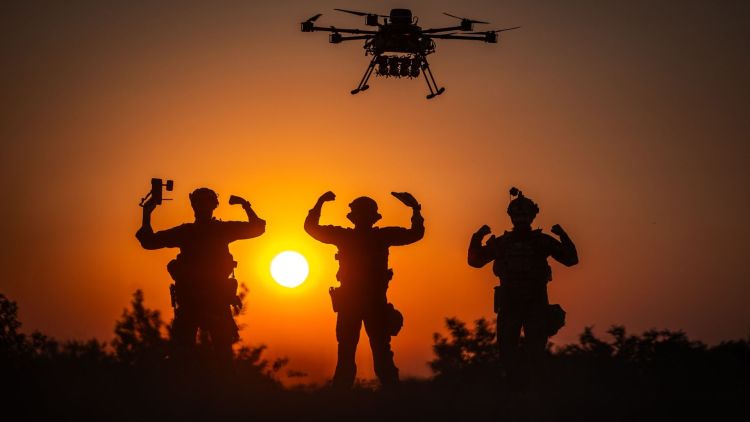Ukraine shocked the world—and even its own allies—by launching a military incursion into Russian territory earlier this month, a bold move that marks a historic turning point in the two-year-old conflict.
This surprise offensive wasn’t just another battle in the ongoing war; it represented a strategic shift that could potentially redefine the future of military conflicts.
Why? Here’s our opinion on the matter.
Modern Hybrid Warfare
Ukraine’s actions offer a glimpse into how hybrid warfare—an evolving blend of traditional combat, psychological operations, and cutting-edge technology—can be employed to disrupt and challenge even the most formidable adversaries.
Well, it’s not exactly news now since hybrid warfare has long been unfolding right before us in recent years, even way before the onset of the 2022 Russo-Ukrainian war.
But it is without a doubt that Kyiv’s implementation of it has brought the strategy to the forefront of modern military thinking.
A Ukrainian soldier prepares a drone. (@ZelenskyyUa/X)
As mentioned, hybrid warfare challenges how we think wars should be fought, combining conventional military force with cyber operations, psychological tactics, and strategic deception in the mix. This renewed cocktail of tactical thinking creates a multifaceted and makes the battlefield more unpredictable. The goal is to surprise and confuse your adversary while using unpredictability to your advantage.
Ukraine’s recent incursion into Russia further highlights this concept and shows how these tactics can be effectively used by a nation facing a larger, more powerful enemy. He doesn’t know where to protect next. Resources are spread thin, aiding in future victories; at least, that is the concept.
Ukraine shocked the world—and even its own allies—by launching a military incursion into Russian territory earlier this month, a bold move that marks a historic turning point in the two-year-old conflict.
This surprise offensive wasn’t just another battle in the ongoing war; it represented a strategic shift that could potentially redefine the future of military conflicts.
Why? Here’s our opinion on the matter.
Modern Hybrid Warfare
Ukraine’s actions offer a glimpse into how hybrid warfare—an evolving blend of traditional combat, psychological operations, and cutting-edge technology—can be employed to disrupt and challenge even the most formidable adversaries.
Well, it’s not exactly news now since hybrid warfare has long been unfolding right before us in recent years, even way before the onset of the 2022 Russo-Ukrainian war.
But it is without a doubt that Kyiv’s implementation of it has brought the strategy to the forefront of modern military thinking.
A Ukrainian soldier prepares a drone. (@ZelenskyyUa/X)
As mentioned, hybrid warfare challenges how we think wars should be fought, combining conventional military force with cyber operations, psychological tactics, and strategic deception in the mix. This renewed cocktail of tactical thinking creates a multifaceted and makes the battlefield more unpredictable. The goal is to surprise and confuse your adversary while using unpredictability to your advantage.
Ukraine’s recent incursion into Russia further highlights this concept and shows how these tactics can be effectively used by a nation facing a larger, more powerful enemy. He doesn’t know where to protect next. Resources are spread thin, aiding in future victories; at least, that is the concept.
As the underdog continues to go up against one of the world’s military heavyweights—Ukraine didn’t just send troops over the border; it launched a complex operation that included disinformation campaigns, cyberattacks, and the use of advanced Western-supplied weaponry.
Drones, electronic warfare, and the strategic infiltration of Ranger units played vital roles in weakening Russian defenses before ground forces moved in.
Disrupting Russia’s Military Plans
One of the most significant impacts of Ukraine’s incursion is how it forced Russia to confront a two-front conflict for the first time since the war began.
This new front not only stretched Russian forces but also disrupted their overall military strategy.
Russia, accustomed to dictating the pace of the war, suddenly found itself reacting to Ukrainian advances on its own soil. The West has mixed feelings about this. Anything that can be viewed as expanding the war will likely be viewed in a negative light. American-made weapons are being used to attack the Russian homeland; this is no small thing. Putin will likely view Ukraine as an American proxy in a direct attack on his people. Tensions could not be higher.
The initial success of Ukraine’s operation highlights the effectiveness of hybrid tactics in disrupting a larger enemy’s plans.
However, after the early rapid gains, the offensive began to slow as Russia reinforced its defenses.
This map, updated on August 16, 2024, offers the latest military intelligence assessment of the situation in Ukraine. (UK Ministry of Defense/X)
The British defense ministry noted in a situation report last Friday that after an initial period of disarray, Russian forces managed to regroup and deploy in greater numbers, creating a stalemate that neither side could maintain indefinitely.
A New Blueprint for Smaller Nations
Ukraine’s incursion into Russia serves as a potential blueprint for smaller nations facing larger, more powerful adversaries.
—a reminder that the classic David versus Goliath anecdote remains true today, even in a world dominated by innovation.
Through hybrid warfare, these nations can punch above their weight, using a combination of traditional military force, psychological operations, and technological innovation to disrupt and challenge even the most formidable opponents.
This approach could inspire other countries in similar situations, demonstrating that conventional military dominance can be contested through creativity and adaptability.
As we look to the future, it’s likely that hybrid warfare will become a central element in military doctrines worldwide, with nations investing in the capabilities needed to wage this type of conflict effectively.
The Role of Western Support
Ukraine’s success in its incursion was made possible in part by the support of its Western allies, who obviously provided advanced equipment and intelligence.
However, this support has been cautious, with strict limits on how some of the more powerful weapons can be used.
For example, while Britain allowed Ukraine to use a squadron of Challenger 2 tanks, it, along with other Western allies, placed restrictions on the use of long-range missiles like the Storm Shadow cruise missile to avoid escalating the conflict further.
This cautious support underscores the delicate balance that Western nations are trying to maintain.They want to help Ukraine defend itself and reclaim its territory, but they are also wary of provoking a direct confrontation with Russia.
This balancing act alone shows just how tricky it is to back a hybrid warfare strategy in today’s globalized world, where one country’s moves can ripple out and affect everyone else.
Long-Term Challenges and Outlook
Ukraine’s hybrid tactics have been innovative and effective, but keeping them going long-term won’t be easy.
Take the upcoming Russian winter, for example – it could really mess with the mobility of Ukraine’s forces. Those Western-supplied wheeled armored vehicles that work so well in the summer might get bogged down in the snow and mud, leaving Ukrainian troops stuck in tough spots.
On the flip side, Russia isn’t just sitting back, either.
They might let Ukrainian forces push forward, only to surround them and flip the situation.
Both sides are constantly tweaking their strategies, so it’s shaping up to be a back-and-forth struggle with no clear winner anytime soon.
Conclusion: Redefining Modern Warfare
Ukraine’s push into Russia isn’t just about taking territory—it’s a clear example of how hybrid warfare is shaking up modern conflict.
Hybrid warfare blends traditional military moves with cyber attacks, information warfare, and unconventional tactics, making it a flexible approach against even the most powerful nations.
As other countries watch this play out, they’re likely taking notes and figuring out how to mix these strategies into their own playbooks.
Looking back, every major conflict had its own evolution in warfare.
The Revolutionary War was all about guerrilla tactics and breaking from European battle formations. The Civil War brought trench warfare and industrial weaponry into the mix. And by the World Wars, we saw full-scale mechanized battles and strategic air campaigns reshape how wars were fought.
Now, with the rise of hybrid warfare, Ukraine is showing that even a smaller nation can adapt and take on a global power using a mix of modern tools and strategies.
While the outcome of this conflict is still up in the air, one thing’s for sure: hybrid warfare is here to stay, and it’s going to change how future wars are fought, just like the warfare before it.
For military leaders and strategists, what’s happening in Ukraine is a blueprint for how innovation, quick adaptation, and understanding of today’s complex battlefield dynamics can help level the playing field between smaller nations and major powers.
—
Disclaimer: SOFREP utilizes AI for image generation and article research. Occasionally, it’s like handing a chimpanzee the keys to your liquor cabinet. It’s not always perfect and if a mistake is made, we own up to it full stop. In a world where information comes at us in tidal waves, it is an important tool that helps us sift through the brass for live rounds.



